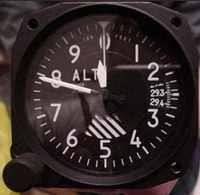Aero-Tips!
A good pilot is always learning -- how many times have you
heard this old standard throughout your flying career? There is no
truer statement in all of flying (well, with the possible exception
of "there are no old, bold pilots.")

Aero-News has called upon the expertise of Thomas P. Turner,
master CFI and all-around-good-guy, to bring our readers -- and us
-- daily tips to improve our skills as aviators. Some of them, you
may have heard before... but for each of us, there will also be
something we might never have considered before, or something that
didn't "stick" the way it should have the first time we memorized
it for the practical test.
Look for our daily Aero-Tips segments, coming each day to
you through the Aero-News Network.
Aero-Tips 06.30.06
 Most aircraft are required to have
an altitude sensing device, and in most cases the altimeter must be
adjustable for variations in air pressure
(Note: common altimeters measure air pressure
and convert that to an altitude display). If the air pressure
changes, and it does, the pilot must manually calibrate the
altimeter by "dialing in" the local air pressure. This is called
altimeter setting.
Most aircraft are required to have
an altitude sensing device, and in most cases the altimeter must be
adjustable for variations in air pressure
(Note: common altimeters measure air pressure
and convert that to an altitude display). If the air pressure
changes, and it does, the pilot must manually calibrate the
altimeter by "dialing in" the local air pressure. This is called
altimeter setting.
Our friends the Federal Air Regulations, of course, address altimeter setting as well.
They tell us:
Each person operating an aircraft shall maintain the cruising
altitude or flight level of that aircraft, as the case may be, by
reference to an altimeter that is set, when operating --
- Below 18,000 feet MSL, to-
-
- The current reported altimeter setting of a station along the
route and within 100 nautical miles of the aircraft;
- If there is no station within 100 nautical miles, the current
reported altimeter setting of an appropriate available station;
or
- If the aircraft is not equipped with a radio, the elevation of
the departure airport or an appropriate altimeter setting available
before departure; or
- At or above 18,000 feet MSL, to 29.92" Hg.
Note that the altitude where "standard" (29.92" Hg/1013.2 mb or
hectoPascal) varies from country to country.
Altimeter Error
Altimeters (under US rules) must be accurate +75 feet with the
current altimeter setting. Say you are sitting at on the ground at
a known elevation above mean sea level (MSL; at the point on the
airport where the official elevation was measured), dial in the
current altimeter setting and note, for instance, that your
altimeter is reading 50 feet high, do you --
- Leave the altimeter set as it is and accept the 50-foot
error;
- Change the altimeter to the known elevation and, for all
subsequent altimeter settings in flight, dial in the setting and
then adjust the altimeter indication by 50 feet; or
- Change the altimeter to the known elevation, note the
difference in altimeter-indicated air pressure from the setting
window needed to make this adjustment, and then apply this
correction to all altimeter settings for the remainder of your
flight?
The FARs don't give us any guidance. My personal opinion is that
the margin for error both in reported altimeter setting and
measured field elevation is large enough that I would (and do)
accept this within-tolerance altimeter error, avoiding the workload
of mental altimeter math in flight.
Another note
Again, the rules don't say so, but it's good to double-check
altimeter setting as part of your approach checklist if you are
flying an instrument approach and/or at night.
Aero-tip of the day: Set your altimeter
properly before flight, and regularly update it as you proceed.
 ANN's Daily Aero-Term (04.20.24): Light Gun
ANN's Daily Aero-Term (04.20.24): Light Gun Aero-News: Quote of the Day (04.20.24)
Aero-News: Quote of the Day (04.20.24) ANN's Daily Aero-Linx (04.21.24)
ANN's Daily Aero-Linx (04.21.24) Aero-News: Quote of the Day (04.21.24)
Aero-News: Quote of the Day (04.21.24) ANN's Daily Aero-Term (04.21.24): Aircraft Conflict
ANN's Daily Aero-Term (04.21.24): Aircraft Conflict




